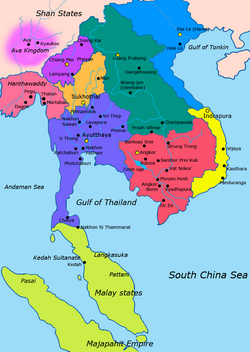Kingdom of Hongsarwatoi (Hanthawaddy) Pegu | |||||||||
|---|---|---|---|---|---|---|---|---|---|
| 1287–1552 | |||||||||
 Hanthawaddy in red in the northwest, c. 1450 | |||||||||
| Status | Kingdom | ||||||||
| Capital | Martaban (1287–1364) Donwun (1364–1369) Pegu (1369–1538, 1550–1552) | ||||||||
| Common languages | Mon Old Burmese | ||||||||
| Religion | Theravada Buddhism | ||||||||
| Government | Monarchy | ||||||||
• 1287–1307 | Wareru | ||||||||
• 1384–1421 | Razadarit | ||||||||
• 1454–1471 | Shin Sawbu | ||||||||
• 1471–1492 | Dhammazedi | ||||||||
• 1492–1526 | Binnya Ran II | ||||||||
| Historical era | Warring states | ||||||||
• Overthrow of Pagan governor | c. January 1285 | ||||||||
• Independence from Pagan | 30 January 1287 | ||||||||
• Vassal of Sukhothai | 1287–1298, 1307–1317, 1330 | ||||||||
| 1385–1424 | |||||||||
• Golden Age | 1426–1534 | ||||||||
| 1534–1541 | |||||||||
• 2nd Fall of Pegu | 12 March 1552 | ||||||||
| |||||||||
| Today part of | Myanmar Thailand | ||||||||
The Hanthawaddy Kingdom (Mon: ဍုၚ် ဟံသာဝတဳ, [hɔŋsawətɔe]; Burmese: ဟံသာဝတီ နေပြည်တော်; also Hanthawaddy Pegu or simply Pegu) was the polity that ruled lower Burma (Myanmar) from 1287 to 1539 and from 1550 to 1552. The Mon-speaking kingdom was founded as Ramaññadesa (Mon: ရးမည, Burmese: ရာမည ဒေသ) by King Wareru following the collapse of the Pagan Empire in 1287[1]: 205–206, 209 as a nominal vassal state of the Sukhothai Kingdom and of the Mongol Yuan dynasty.[2] The kingdom became formally independent of Sukhothai in 1330 but remained a loose federation of three major regional power centres: the Irrawaddy Delta, Bago, and Mottama. Its kings had little or no authority over the vassals. Mottama was in open rebellion from 1363 to 1388.
- ^ Coedès, George (1968). Walter F. Vella (ed.). The Indianized States of Southeast Asia. trans.Susan Brown Cowing. University of Hawaii Press. ISBN 978-0-8248-0368-1.
- ^ Htin Aung 1967: 78–80
